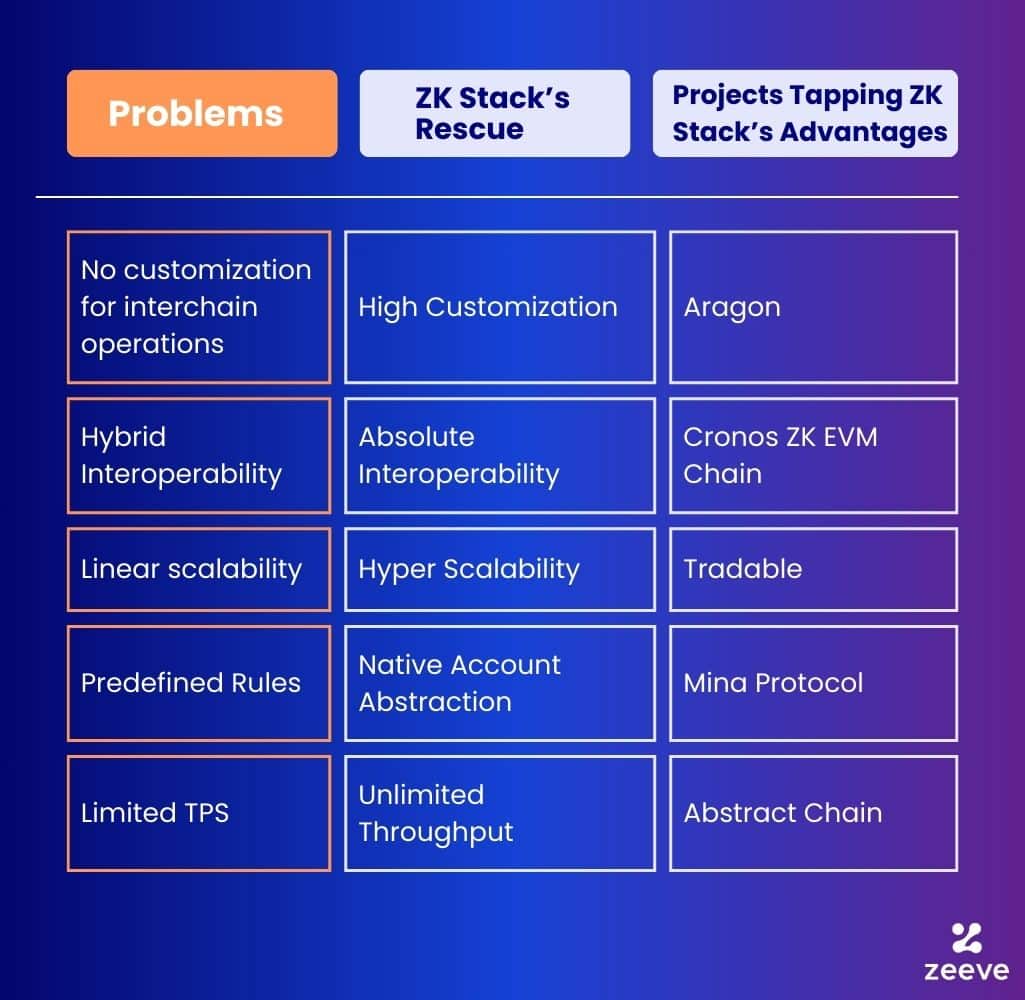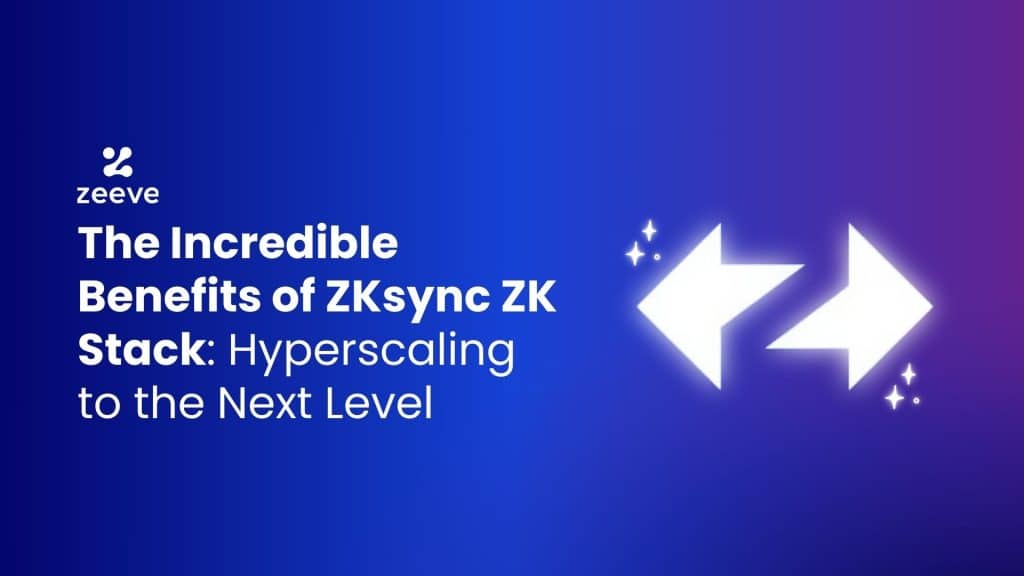Developing an application on top of a blockchain is complex because every blockchain has specific rules based on which they operate. Due to this, Web 3 space has failed to mature as a one ecosystem where everything can co-exist, operate among themselves and scale simultaneously sans complexity. However, ZKsync’s ZK Stack is all set to change that from the ground up.
What is ZKsync’s ZK Stack?
ZKsync’s ZK Stack is a modular, open-source framework with the features to build sovereign chains with absolute interconnectivity among them. All the ZK chain(s) have the trade-off of independent operations with scalability where they can define their own logic and governance while inheriting the openness, security and liveness of the L1/Ethereum chain.
How ZKsync’s ZK Stack Benefits The Web 3 Space To Mature Ahead?
As we know that the Web 3 space is vast with different chains having different rules and running in parallel. In order to make these chains work together, the need for a stack arises that guarantees;
Sovereignty/ High Customizability
Sovereign is at the heart of every blockchain. Due to this, every blockchain ecosystem is different and they resist customization to meet other blockchain’s needs for security purposes. For example, Ethereum chose Solidity for integrating smart-contracts, Polkadot chose Rust for security and modularity. Likewise, other blockchains have their own particular reasons for the choice of language that can keep them secure and sovereign. However while doing the same, they make their ecosystem guarded.
Now, if different blockchain protocols want to communicate with different technology stacks, they need to build bridges from scratch for every chain that they wish to communicate with. This makes interoperability a very costly pursuit.
ZK Stack introduces LLVM compilers which help the developers, who might not know solidity, to build specific toolchains for their smart-contract language. The LLVM works by consuming the Intermediate Representation (IR) of a different chain and applies the extensive optimization that converts that foreign language into ZkEVM or any other blockchain specific VM bytecodes and creates a ZK-EVM or Zk-any other chain text assembly output data to link a source and destination chain, which might be native or non-native, a benefit of ZKsync’s ZK stack simplifying customization.
Hence, in this way, the LLVM decouples the need for a homogenous tech stack . On the contrary, even heterogeneous tech stacks can operate and co-exist at the same time without diluting their sovereignty while enjoying absolute customization.
Interoperability
Interoperability is another major hurdle because if you want to communicate with different chains, you have to use a bridge that dilutes the UX in the Web 3 space. At the same time, using these bridges is costly because you have to do burning and minting of assets at the entry and exit points, which amounts to doing more than one transaction with additional gas spending. Thereby, exposing vulnerabilities, which we have seen in the past.
ZKsync’s ZK Stack benefits developers by abstracting the same through Elastic Chain(s).
These ZKsync Elastic Chains perform different functions based on the environment where they are used.
Source: ZK Stack
For example, as you are seeing in the image above, we are having a native interoperability where all the ZK Chain(s) formerly known as Hyperchains are connected. In such a situation, the ZK Chain(s) will act like a single blockchain and users will require just a single wallet to interact with different ZK Chain(s). In case, if you have read about the aggregation layer of the Polygon chain, you will be able to understand how the native interoperability works with the polygon ecosystem.
While when it comes to shared/Interoperability, the use of a messaging protocol/ZK Gateway as shown in the image below that connects to all the chains via a Merkle Trie to send and receive transactions and build asynchronous connections with cross-chain applications will be used. In this way, the ZK Chain(s) allow every independent ZK Chain to maintain their own sovereignty while enjoying the interconnectivity, allowing the ZK chain(s) to retain full control, if they wish to transition away from the ZK Stack without compromising the liquidity at any point.
Source: ZK Stack
HyperScalability
Imagine every single chain posting an event on their blockchain to the settlement layer for finality. In such a situation, it would put a lot of pressure on the settlement layer to validate those transactions coming from all these chains at once due to a fixed block space. Thereby, leading to chain congestion and high gas cost on the rollup chains. In order to solve this problem, ZKsync’s ZK Stack makes use of the interoperability cross-chain bridging protocol or ZK Routers and a shared prover for creating a fractal-like scaling situation.
The trade-off results in instead of submitting multiple proofs emanating from different rollup chains, a single proof is submitted to the settlement layer ensuring hyper scalability to occur at every ZK Chain connected through a ZK Gateway. In addition to this, since these ZK chain(s) retain their sovereignty, they have full control over their assets and they can transition away from ZK Stack through an asynchronous connection, allowing cross-chain interaction at any time.
Source: ZK Stack
Native Account Abstraction
So far we have seen that users have to pay for the transaction that they do within an ecosystem. Such functionalities could be burdensome for the users when they want to use an application. ZK Stack, is the only rollup to introduce native account abstraction that allows arbitrary logic to be used in the smart-contract for operations. So, all the accounts in the ZKsync Era can use smart accounts and pay-master features that allow full programmability to be introduced for user wallets.
As a result, the platform can abstract the gas fees by fully scrapping the same or allowing payments in any tokens of the choice. Zero Network, an application built on top of the ZK Stack as ZK Chain(s) has done the same using a custom paymaster option on their Zerion Wallets, where Zerion pays on behalf of the users. Other features also include native multisig for wallets where a threshold limit can be set for signing transactions.
In addition to this, ZK Stack also provides an account versioning option where an account can opt for the version that they wish to stick with. In this way, it is also possible to go for backward compatibility allowing innovations to occur without disturbing the functionalities of the existing chains on which those accounts exist.
Throughput
When you are speaking about the maturity of a technology, it should be such to accommodate the growing adoption, like the Internet. ZKsync’s ZK Stack benefits developers in such a way that as the network expands, the capacity will expand likewise. However, it is easier said than done. But ZK Stack brings recursive proofs to solve the problem of obtaining hyper scalability, where recursive proof generation allows unlimited parallelism for proof generation to occur through the use of constant-time verification using the ZK Router for native chains and ZK Gateway for non-native chains.
The trade off that ZK Gateway and ZK Router provides is instant messaging of events scattered across various ZK Chain(s) to achieve hyper throughput. Outcome, Polygon’s ZkEVM, and Optimism’s Op Stack while handling more than 100 accounts sent transaction on the network with an average processing time of 5.4 tx/s and 142.8 tx/s respectively, ZKsync’s ZK Stack could clock 181.8 tx/s.
Top Blockchain Projects Using the ZKsync’s ZK Stack For Its Benefits
The benefits of ZKsync’s ZK Stack has expedited development and simplified the process of deploying solutions on top of blockchains. Now, anyone can launch their roll-up chain in a flash and enjoy high liquidity, interoperability and hyper scalability. These trade-offs have attracted some of the key projects to use ZK Stack as their go to framework like;
Cronos Zk EVM Chain
Cronos is launching the Cronos ZkEVM chain, which will be customized for sectors like DeFi and GameFi. So far, Crypto.com, VVS Finance, Fulcrom Finance, and Veno Finance have used the benefits of ZKsync’s ZK Stack for developing their application because they wanted to enjoy hyper scalability while maintaining the security at the same time. With the existing bridging solution, the users are like sitting ducks for raids. Cronos wanted a trustless model and ZKsync’s ZK Stack benefits them at large in this regard. The Cronos Labs‘ head Ken Timsit says, “In the end, the main reason we’re interested in ZK-rollups is that they solve one of the great sources of frustration we have had over the years, which is the lack of security of cross-chain bridges.”
He further adds, “ What’s very interesting about ZK-rollups is the fact that we can have multiple Layer 2s who share the same zero-knowledge circuits, and because they share circuits, they’re able to prove to each other that a cross-chain transfer or that an action has taken place across multiple chains without having to go via Ethereum and without having to rely on third party bridge operators, which have experienced many security incidents in recent years.”
Tradable
Tradable as a platform wanted to integrate Tradfi with DeFi. However, in this pursuit, they wanted limitless accessibility to pools of assets which only cross chain operations can guarantee. As a result, to extend the private credit to users, Tradable chose ZKsync’s ZK Stack because it provided quick access to a wider market and made more sense to institutional grade investment. One of the key reasons that institutions went with Tradable was the privacy, interoperability and security that Tradable provided to its users through the ZKsync’s ZK Stack benefitting their long term vision of scalability with security.
Mina Protocol
Mina protocol is another project which is using ZKsync’s ZK Stack to produce very small proof sizes for a light weight blockchain. Since the protocol is aiming to check increasing instances of deep fakes and reduce blockchain centralization, it is mandatory to keep the blockchain size small. ZKsync’s Zk Stack benefits in this regard by generating recursive proofs which are very small to keep participation open and available for all.

Setting Up Zk Chain(s) with Zeeve
Zeeve Rollups-as-a-Service has been customized to meet the growing need of L2s and L3 development. Using the Sandbox tools for ZKsync Elastic Chains, Zeeve is providing all the necessary technology and infrastructure support to build your own ZK Chain(s). Through this support, project’s time to market can be cut into half since you can save as high as 90% of the time marketing and promoting your product, which would have otherwise been spent on development. In addition to this, by harnessing our age-old existence in space, Zeeve brings more than 30+ integration partners to supercharge your hyperchain environment. If you want to get more information about launching your hyperchain, our experts are just a call or a click away.





